Original Title: Keoma
Year: 1976Director: Enzo G. Castellari
Writer: Enzo G. Castellari (screenplay), Nico Ducci (screenplay), George Eastman (screenplay, story), Mino Roli (screenplay), Joshua Sinclair (dialogue (uncredited))Genre: Western
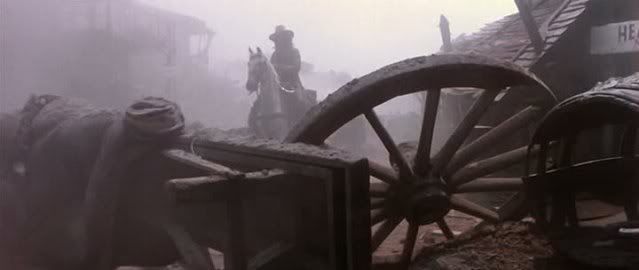
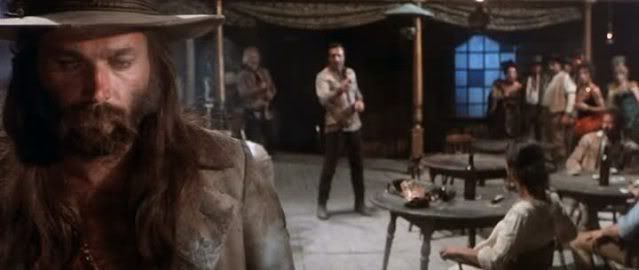
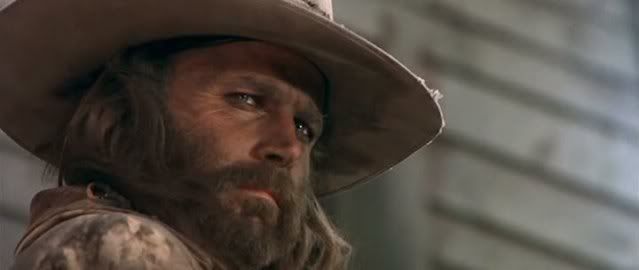
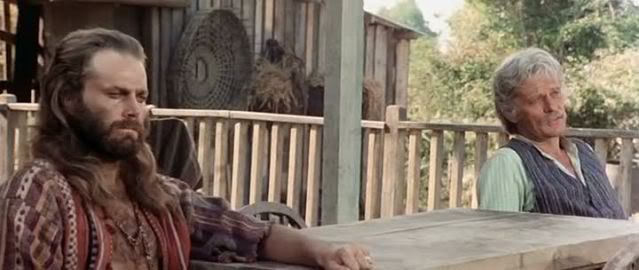


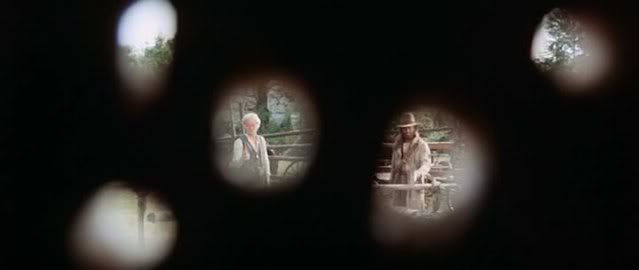
imdb synopsis:
Half-breed Keoma returns to his border hometown after service in the Civil War and finds it under the control of Caldwell, an ex-Confederate raider, and his vicious gang of thugs. To make matters worse, Keoma's three half-brothers have joined forces with Caldwell, and make it painfully clear that his return is an unwelcome one. Determined to break Caldwell and his brothers' grip on the town, Keoma partners with his father's former ranch hand to exact violent revenge.I've been reading varying opinions on Keoma today after viewing it myself. After recently hearing an interview with Enzo Castellari thanks to the fine folks of Pop Syndicate, Outside the Cinema, and The Gentlemen's Guide to Midnite Cinema, I decided to save this one until last. The last viewed and the last reviewed film of my unofficial Castellari Month. Castellari said in his interview that this was his favorite genre to work in, that Franco Nero was his favorite actor to work with, and that Keoma was his favorite film to work on. Ever.
So how could I not save it until last?

Of all of Castellari's films that I have watched lately and ever, this one was the deepest and most challenging for me. On my initial viewing, I can understand why he chooses this one as his favorite. Coming at a time when Spaghetti Westerns were almost completely out the door, Castellari seems to pay homage to some of the great elements of the genre from the beautiful scenery and super wide aspect ratio, to the grit and grime and existential nature of the violence, to the (from what I have read) Peckinpah-inspired action sequences.
And here's my little admission/disclaimer:
I have yet to see a Peckinpah western.
I need to get busy, eh?

In a 2007 interview with Castellari, he described the challenges behind the film. When he was initially given the script, he hated it. Instead of proceeding and making what he felt would be a flop, or canning the project entirely, Castellari in a way took the film under his wing and reinvented it. He rewrote the script day by day as they were filming, pulling elements from here and from there. You can see elements of westerns that came before. And he described elements of stories he pulled from to recreate the story of Keoma, from the influence of Death in the Seventh Seal, to Mark Antony's funeral speech from Julius Cesar. Keoma is meant to be seen as a Christ like figure, trying to save this village despite at some point pretty much everyone disliking or just not caring about him.
Sometimes you can get that feeling that this film was being created as it was going as it seems dreamlike and free-flowing from time to time, but I am amazed that Castellari pulls what is in my opinion a successful and cohesive plot with depth out of the proverbial coals. He spoke of his relationship with Franco Nero and the great trust Nero had for him, as well as the trust his producer had in him, which was essential when flying by the seat of his pants like this.
When you hear him talk about this film like this, and how much of himself he put into it, you can understand why it is so dear to him. After hearing him speak about the film, and about his beliefs of the ever-presence of violence in society and how sometimes violence is a necessary thing, you can see that same theme recurring in much of his work.

Franco Nero is phenomenal as Keoma. He may not be the most convincing half-Native American of all time, being white with a somewhat-heavy Italian accent and all, but he plays this role with such an intensity and with an underlying despair that you can feel it yourself. Keoma wants to fight for life, and you can believe the character's sadness and frustration of the state of his home upon his return as Death has settled in. Nero looks animalistic in this film with his mane and unkempt facial hair; quite a departure from the usual mustached hero we usually see him as.

This is a role for Nero that carries the film, but that's not to say the supporting cast are not significant. Keoma's father William (William Berger) is understated and solid. Keoma comes back to him after many years, and the slow rebuilding of their relationship is handled well I though. There is a nice scene with the two of them talking on the porch of his old homem the camera rotating around them very slowly. At times they seem very far apart but they are ultimately brought close together once again.
Keoma's half brothers all do a decent job and look great in masks. The beautiful Olga Karlatos as the pregnant Lisa does a nice job also.

Woody Strode plays George, a freed slave, now alcoholic, that was with Keoma's family when Keoma was a kid. Woody plays the part very well and makes for a very endearing character. I felt for him as well - a connection from things as simple as his facial expressions. His relationship with Keoma, while unfortunately brief in the film, was interesting I thought as the two share a bond in that George played what seems to be a big role in Keoma's upbringing and their being two non-white individuals living in a dangerous time for non-whites (post-Civil War American West).
The story as I mentioned is dreamlike at times, with flashbacks woven into present time. We see Keoma watching himself as a child, getting chided by his half-brothers. We see an old woman following him around, representing Death in a sense, and I was never quite sure if she was really supposed to be there or not.
I have seen complaints that this is just rehash. I can agree with that in a sense, but it isn't a rip-off job to me, but instead perhaps a collage. I feel like it is done with a sense of style and with a reverence that make it stand on it's own. Knowing Castellari's history with the film and with the story's ultimate influences aids in my enjoyment of it I think.
Instead of being a simply cut-and-paste story set in the West, we get reflections on life and death, the circle of it all, and the role of violence in the whole scheme.
"The world keeps going around and around. So you always end up in the same place."


Castellari and director of photography Aiace Parolin paint a beautiful picture with Keoma. It looks fantastic and even hellish at times with certain shots of the run-down village. The scenery was beautiful and very spacious. I liked the use of slow-motion quite a bit (I'm still a sucker for it), and Castellari's experimental side shows nicely once again with some interesting angles and takes on what would be just typical events in a Western.
Look for Keoma and William's target practices, for shots through legs (a Castellari staple), and one marvelous shot with Keoma counting to four, lowering fingers one by one to reveal men standing there. Out-feggin-standing stuff.
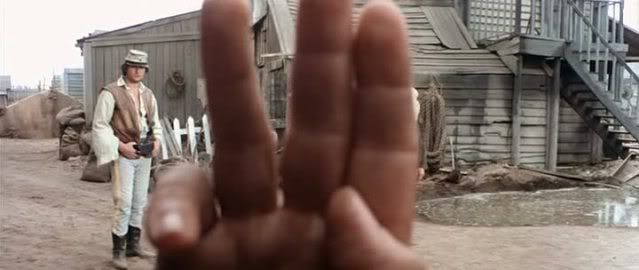
One complaint I have about the film, and I share this sentiment with many people it seems, is the soundtrack. This is kind of a major complaint. Castellari wanted the soundtrack to be a take on the music of Leonard Cohen and Bob Dylan... a folky approach to quirky storytelling. And the stories told would be done so by those with no necessarily the best singing voices. Where I love Cohen and Dylan, the music here got in the way for me. The songs served as narration, for example telling Keoma to run away! Run far, far away! As far as you can! At times it worked when it was minimal.
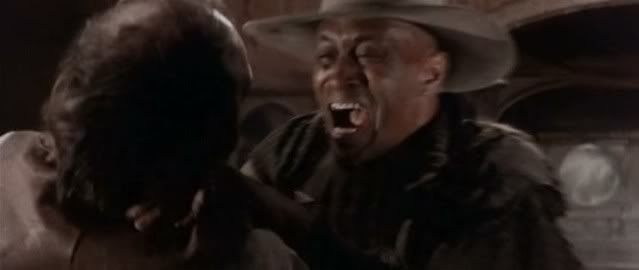
The woman's voice in particular had a sometimes haunting-quality to it which worked with the feel of the film. But by the end of the movie it began to feel like parody. I was waiting for a song narration saying Keoma missed his mom, and now he was hungry, and now he needed to drop a deuce. It largely did not work for me, and I wish a different decision was made regarding this style of soundtrack.
Ultimately though, I really liked Keoma. Solid performances, a nice, serious tone, beautifully shot, and knowing the background and Castellari's affection for the story, it's process, and his strong relationship with Nero all added to it.
It's not a masterpiece, and I still think Castellari's first work with Nero in High Crime is superior, but Keoma is worth putting up against other strong spaghetti westerns regardless of the time it was made. I would score it higher if not for the music... it was that big a deal for me.
High recommendation.
7.75 out of 10
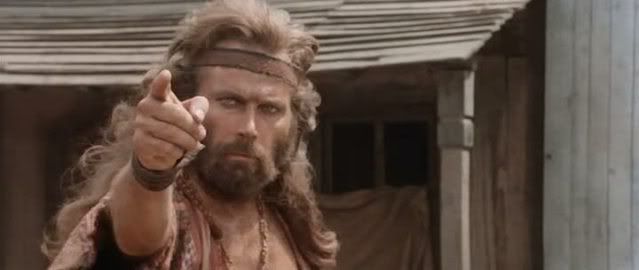

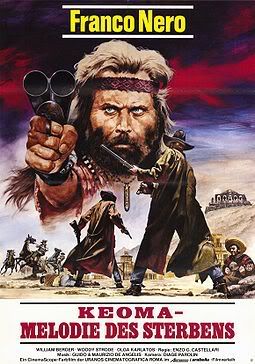
1 comment:
That last screen cap looks like it could've easily come from the post-apocalyptic stuff you've been reviewing as well!
Nice review, this is one I've had my eye on at Amazon, but hadn't taken the plunge for, may have to fix that now.
Post a Comment